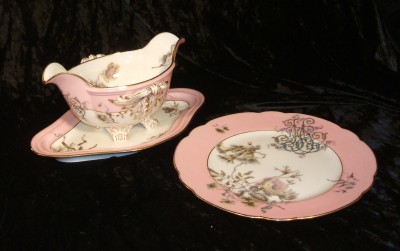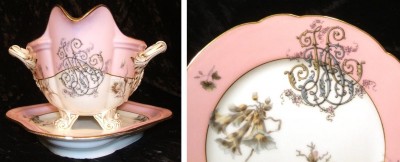Hutzler family porcelain dishes, circa 1878

A blog post by Collections Manager Joanna Church. To read more posts from Joanna click HERE. To read even more posts about our collections click HERE.
Today we have two pieces from a larger set of porcelain dinnerware, owned by the Hutzler family of Baltimore.

We have a sauce boat, with molded (attached) underplate, 9 inches long; and a dessert plate, 8.5 inches in diameter. The decoration manages to be both elaborate and – at least compared to some other examples of late 19th century French porcelain – fairly restrained: the pink is bright and the morning glories are plentiful, but the gilding is kept to a minimum, and the entwined initials (off to the side on the plate, and on one end of the boat) are relatively subtle. Both pieces are marked on the reverse with the cartouche of Adolphe Hache & Pepin LeHalleur of Vierzon and Paris, France. Hache & LeHalleur, a porcelain decorating firm, exhibited at the 1876 Centennial Exposition in Philadelphia, and won a Gold Medal at the 1878 Paris Exposition. (That 1878 award was proudly added to the maker’s mark, as you can see from the photo below.)
![The reverse of the dessert plate: “1878 Méd.e D’or [Médaille D’or (Gold Medal)] Paris / Ad. Hache & Pepin LeHalleur / Vierzon [and] Paris”](https://jewishmuseummd.org/wp-content/uploads/2014/11/makers-mark-on-dessert-plate-400x342.jpg)
According to family stories, “Grandfather Hutzler” (David) commissioned the full dinnerware set “at the Paris Exposition.” But which Paris Exposition? The maker’s mark dates from between 1878, when Hache & LeHalleur won their award, to 1889, when the firm’s name (and mark) changed. That gives us the 1878 and 1889 options to choose from, and I lean toward the 1878 Paris World’s Fair or Exposition as the origin of our dinnerware set. Something sold directly at the Exposition would not have that “We won an award!” mark on it already (unless the firm was very confident, I suppose), but it makes sense that porcelain custom-ordered at the fair, then manufactured afterward, would include mention of the maker’s just-awarded Gold Medal.

A side note on the color: Today, we tend to associate pink so closely with femininity and girlishness that it’s easy to apply those same attributes to antique pink… but we shouldn’t necessarily do so. Not only was pink an entirely appropriate color for boys until the early 20th century, but this particular shade of “French pink,” introduced by Sevres in the mid-18th century, was a very popular ground color for china and porcelain. The Hutzlers showed good taste in acquiring a fashionable, expensive, and custom-made set, and no doubt they enjoyed serving family and friends from their French porcelain.
After Ella died in 1942, her children made an inventory of the family home on Eutaw Place in order to appropriately distribute their parents’ belongings. A “pink Limoges set of china” – almost certainly the set from which these pieces originated – was listed next to son Albert’s name; the set was likely divided up further and given to the younger generations as time passed. Our dessert plate was donated by Albert’s daughter, Caroline Hutzler Bernstein; the gravy boat came to us from Patsy Perlman, one of David and Ella’s great-granddaughters through their daughter Cora.
Though we don’t have the full set (no pink-china dinner party vignettes for our museum, alas!) these two pieces help us illustrate a variety of stories, from Baltimore residents’ access to European fine goods, to a well-to-do couple’s use and display of said goods, to the way a family deals with a deceased parent’s estate. When browsing my “blog post potential” list today the dessert plate caught my eye, thanks to its charming decorations; but when you look closer, there’s much more to it than just what’s on the surface.

4 replies on “Hutzler family porcelain dishes, circa 1878”
bALTIMORE SMALL PLATE? ANY INFO. Thanks
Hi Frank – not sure exactly what you’re asking about, but please contact our director of collections, Joanna Church, at jchurch@jewishmuseummd.org with your questions!
Best,
Rachel
JMM Marketing Manager
My great grandmother was adopted by the Hutzler family in Germany in the late 1800’s and her maiden name was Heyder. Both names originate in Belgium. I am hoping that you might be able to tell me Jewish families only adopted Jewish children because I am trying to find some small hope that my family has some Jewish roots. She did have a curious porcelain vase from Germany. 3 frogs were standing together with their mouths open so that flowers could be placed there. There are no markings on it, but I know it is old. If you have any ideas or direction for me, I would greatly appreciate them. Thank you for your time. Have a good day.
Unfortunately, we don’t have any answers for you regarding the adoption or the vase itself. For the former, I recommend you contact a professional genealogist who can guide you on how and where to do research; we can’t say for certain that Jewish families only adopted Jewish children, and our collections do not include resources regarding European adoptions. For the latter, I’m afraid I am not an expert in ceramics and am not able to tell you anything more about it. I suggest trying some internet image searches using a more specific description of the item, which could give you some clues as to date or manufacturer of similar pieces.